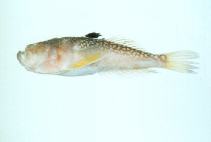|
Uranoscopus japonicus Houttuyn, 1782 |

|
|
photo by
Shao, K.T. |
| Family: | Uranoscopidae (Stargazers) | |||
| Max. size: | 18 cm TL (male/unsexed) | |||
| Environment: | bathydemersal; marine; depth range 250 - 300 m | |||
| Distribution: | Western Pacific: southern Japan to the South China Sea except Ryukyu Islands. | |||
| Diagnosis: | Dorsal spines (total): 4-6; Dorsal soft rays (total): 13-15; Anal soft rays: 13-15; Vertebrae: 26-26. Lower edge of preopercle with 3 spines, very rarely to be more. Labial fimbriae simple and poorly developed. Posterior nostril slitlike. Dorsoposterior margin of pectoral fin slightly concave; pectoral and caudal fins pale yellow in fresh specimens. Fifth proximal anal pterygiophore (the first to follow a complete haemal spine) usually inserts between the haemal spines of 13th and 14th vertebrae (Ref. 11439). | |||
| Biology: | Found near shore, down to 260 m, on sand and sandy mud bottoms (Ref. 11230). Spend a large part of their time buried in the mud or sand with only their eyes and a portion of the mouth protruding (Ref. 4716). Cleithral spine with venom gland (Ref. 57406). | |||
| IUCN Red List Status: | Least Concern (LC); Date assessed: 04 February 2009 Ref. (130435) | |||
| Threat to humans: | venomous | |||